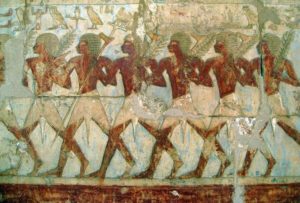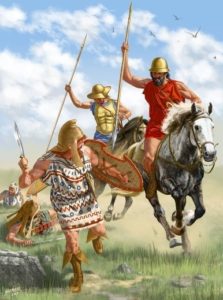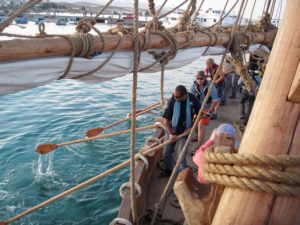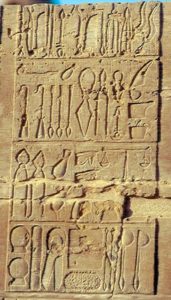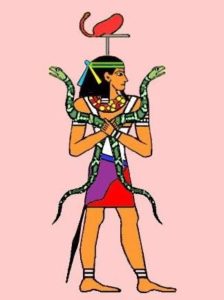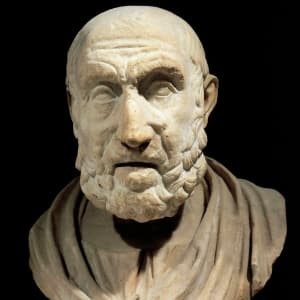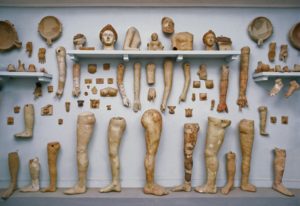Introduction
A previous article described the prehistoric origins of weapons, ships and medicine. Although hominids began using weapons for hunting animals up to five million years ago, the earliest archaeological evidence of their use by Homo sapiens for warlike purposes (as opposed to other forms of interpersonal violence) is only dated to c11,000 BCE. This may indicate how the struggle to survive became rather less dire with the advent of farming and animal domestication from c12,000 BCE, and the ensuing increased differentiation of commodities within and between the first settlements that were considered worth trading and/or fighting for.1
These events initiated a cycle whereby increasing trade drove a need for larger and more efficient ships to transport merchandise, and for better weapons to defend or attack them; both of which in turn facilitated more trading opportunities. However, it was not until the 18th century that maritime medicine had developed sufficiently for its role as an enabler of this cycle to be recognised, thereby making possible the European settlement of Australia.2
This article describes, for better and for worse, the technical and other developments in warfare, ships and medicine in ancient Egypt and Greece from c4000 to c30 BCE.
Ancient Egyptian and Greek Warfare
Many early settlements would have needed protection from external aggressors, who themselves required bases to operate from. The weapons to both these ends were made of wood and stone until the development of bronze alloy in c3500 BCE resulted in the first such weapons from c2000 BCE. These were displaced by weapons of tempered steel made from wrought iron from c900 BCE.3,4
Whatever fighting occurred between these early farms, hamlets, and villages was probably conducted by informally organised groups. The size and scope of their operations would have been limited by the supplies and social structures that sustained them, as well as the lack of reasons to fight beyond the immediate needs of their communities. Hence, it seems likely that much of the fighting during this period was largely ritualistic, with few combat casualties.5,6
However, by c4000 BCE the suitability of what is now modern Iraq for agriculture and trade between India and the rest of the Middle East led to the first towns and cities in what became ancient Sumeria. The next 2000 years saw the development of new weapons such as battle axes, composite bows, armour, chariots and cavalry, as well as innovations as to their use such as phalanx formations, rank hierarchies and headquarters staffs. These advances were made possible by societal developments that could sustain formed armies and provide them with the means and rationales to fight. The first such society was the Assyrian Empire, which waxed and waned at various times in modern Iraq, Turkey and Egypt from c1900 to 612 BCE.7,8,9
The bow remained ancient Egypt’s weapon of choice throughout their military history, possibly because the hot climate prevented them and their opponents from wearing armour. Egyptians first began using them for fighting from c3000 BCE, at which time their arrowheads changed from stone to obsidian. Obsidian arrowheads was replaced by bronze around 2000 BCE, and then by domestically produced iron arrowheads from c1000 BCE.10
The first wheeled carts were developed in the Middle East in c3150 BCE, while the steppe-dwellers of modern Russia had domesticated horses for meat and milk (and later to ride) sometime before 2500 BCE. The latter combined these two elements to create the first horse-drawn chariots from c2000 BCE. These consisted of a light two-wheeled cart drawn by one or more horses, with a driver and a ‘weaponeer’ armed with javelins or bows. The Egyptians used chariots to race into positions where they could shower their opponents with arrows, and then withdraw before being counterattacked. The greater mobility of cavalry led to the abandonment of chariots by 400 CE.11,12
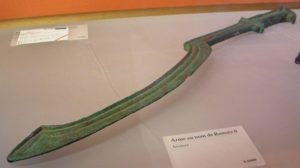
Bronze Egyptian sickle sword or ‘Khopesh’, c1200 BCE.15 Most Egyptian soldiers used bows, spears, axes or maces.
The Greek phalanx (‘finger’) infantry formation can be dated via the Egyptians to Sumerian times. It consisted of a close-packed formation of soldiers (‘hoplites’), each protected by a helmet, breastplate, greaves (shin guards), and shield that each man interlocked with their neighbours, while armed with a sword and long thrusting spear.16,17
Tactics entailed each row of hoplites being pushed by the one behind through an opponent (assuming they stood their ground), in a highly bloody form of ‘reverse crowd control’.18 Their flanks were protected by unarmoured and hence more mobile infantry (‘peltasts’) armed with javelins, while cavalry were used to ride down defeated opponents.19 Archers were used to break up opponents prior to attack by the phalanxes, and to defend against cavalry.20
The most important land battle in ancient Greek history was fought in 480 BCE at Thermopylae, a narrow pass between the Malian Gulf and Mount Kallidromo, in north-eastern Greece. About 7000 men from several Greek city-states held off up to 80,000 invading Persians for three days.21
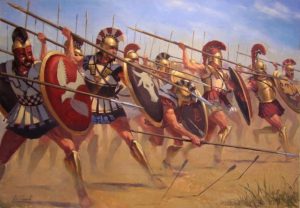
Greek hopites in action, c500-c300 BCE. 22 Note the spears, interlocked shields, helmets, breastplates and greaves.

Greek peltast (light infantryman), c500-c300 BCE.23 Note the lightweight shield, javelins and lack of armour.
Ancient Egyptian and Greek Ships
The previous article described how the first watercraft were limited by their small size and limited seaworthiness to inland rivers, lakes and estuaries. Yet the earliest evidence of Mediterranean seafaring (dated to 10,000-3000 BCE), are obsidian flakes found in mainland Greece from Melos, an island 50 nautical miles offshore.25
The first evidence of true seagoing ships is dated 2000-3000 BCE, from Egypt. They were built of papyrus reed until increasing trade with modern Israel and Syria led to the use of imported wood. These ‘Byblos’ ships used ‘shell-first’ construction, with mortise-and-tenon joints between planks jigsaw-fashion, which were secured with rope and made watertight with plant material. Ribs were added to form the hull, while the lack of a keel led to a large rope being strung from bow to stern above the deck as a ‘hogging truss’ for longitudinal strength. These ships used both sails and oars, to voyage as far as the east coast of Africa in c1400 BCE, and India 300 years later.26,27,28
The Egyptians also had the first Navy, which was used to rapidly move troops along the Nile. The first known sea battle occurred in 1278 BCE near the Nile delta, between a force led by the Egyptian pharaoh Ramesses II, and the ‘Sea Peoples’ whose origins remain unknown. This engagement, like many others until the 16th century CE, was fought with land troops.29
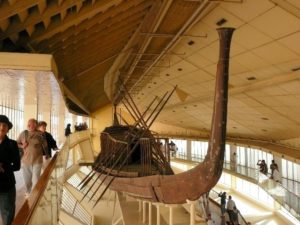
Khufu ship, dated c2500 BCE, bow view 30. She is 43.6m long, 5.9m beam, displaces 45 tons, and is one of the oldest, largest, and best-preserved vessels from antiquity.
She was found in a pit at the Giza pyramid complex, disassembled into 1223 pieces but otherwise complete, in 1954. 31
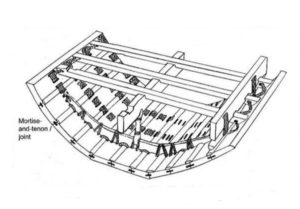
Construction technique, Khufu ship.32 Note the small pieces of wood (tenons) that fit into opposing slots (mortises) between each plank, and how the joints between the latter are covered by battens. Also note the lack of a keel, the ribs used to add transverse strength, and how the whole structure is roped together.
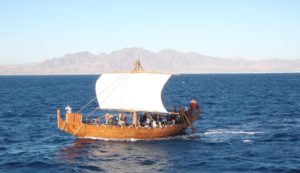
Replica Egyptian seagoing ‘Byblos’ ship Min of the Desert, from c1500 BCE.33 Note the sail, the fore-and-aft antihogging truss, and places for oars.
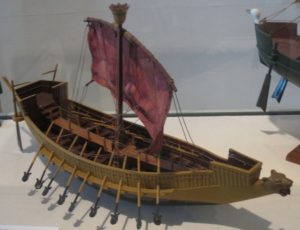
Replica model Egyptian ‘warship’ from c1200 BCE.35 Note it is essentially the same as near-contemporary Egyptian merchant ships.
The first dedicated warships were built by the Greeks from c800 BCE. These used similar mortise-and-tenon joints as the Egyptians, but had a true keel for longitudinal strength, and were fastened with wooden dowels or ‘treenails’ rather than rope. As they had 50 rowers (25 each side) in a single row or ‘bank’, these ships were known as ‘pentecontors’.36,37
Pentecontors and their successor galleys used oars during battle, after landing the masts and sails used to make extended passages.38 Their speed and endurance under oars were restricted by their rowers’ strength and stamina, while that under sail was constrained by their limited food and water stowage, as well as the inability to cook or even sleep at sea. As these ships therefore had to be drawn up on a convenient beach each night, and the latrine arrangements for the rowers in particular would have depended on coordinating how they were released from their oars, it seems likely that each evening included some highly unpleasant bilge-cleaning, with all the ensuing hygiene issues.
Pentecontor tactics entailed sweeping close inboard to smash their opponents’ oars and injure the rowers, which made them vulnerable to then being sunk by ramming.39 By 700 BCE, the need for additional power for more effective ramming led to double- (bireme) and triple-banked (trireme) ships with up to 180 rowers. As their inability to row and fight simultaneously meant the rowers’ combat role was limited to fighting ashore, Greek triremes carried up to ten hoplites and four archers to shoot up their opponents.40,41
The most important sea battle of the era was fought within days of the Battle of Thermopylae, in the strait between Piraeus (near modern Athens) and the island of Salamis. The Greek historian Herodotus (484-425 BCE) describes how 400 triremes commanded by the Athenian general Thermistocles defeated 1200 ships under Ariabignes, brother of King Xerxes of Persia.42

Replica Greek Pentecontor Argo from c800 BCE.43 Note the rather petite ram bow and single bank of oars.

Replica Greek trireme Olympias from c700 BCE.44 Note the more prominent ram bow with bronze beakhead, and oars banked in three vertical layers.
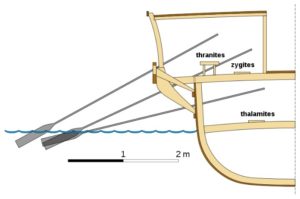
Greek trireme rower arrangement, c700 BCE.45 Note the low freeboard resulting from the thalamite oar ports.
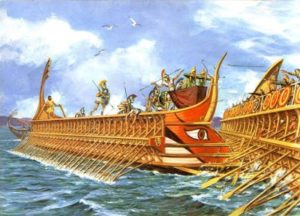
Greek trireme in action, 480 BCE.46 Note the absence of the mast and sail, and the hoplites and archers on the upper deck. Also note the oblique ramming angle, which not only holes their opponents’ hull, but also breaks more
oars (thereby also injuring more rowers) compared to perpendicular ‘T-boning’.
Ancient Egyptian and Greek Medicine
The previous article described how identifying surgical treatments for uncomplicated cuts, abrasions and limb fractures during the prehistoric period was probably fairly straightforward, but less so for medical conditions because of the inability to accurately diagnose them, or to match diagnos(e)s to the right doses of the right therapeutic agent(s). Whilst many medications therefore failed with respect to being actively therapeutic, discovering their relative non-toxicity meant they were unlikely to do much harm, while facilitating the emotional, social and spiritual support provided by caregivers. It seems likely that these agents became the basis of folklore-based treatments, which probably led to at least some modern complementary medicines.47
The cause of disease in ancient Egypt were ascribed to sin, or that the patient was under attack from a demon or ghost, or that a god wanted to teach them a lesson. Treatment therefore entailed driving away the ghost or demon, placating the god(s) who caused the illness, or invoking protection from a higher god as a preventative.48
The god of magic Heka was also a god of medicine, who carried a staff entwined with two serpents.49 This symbol was passed on to the Greeks who associated it with their god of healing, Asclepius, which is still recognisable today as a symbol of the medical profession.50 Other Egyptian healing deities included the warrior or lion goddess Sekhmet,51 the scorpion goddess Serket,52 the crocodile god Sobek,53 and the lotus blossom god Nefertum.54
Hence, Egyptian doctors recited incantations with the use of amulets, offerings, aromas, tattoos, and statuary. Their incantations were recorded on papyrus scrolls that became the medical texts of the day. For example, the Demotic Magical Papyrus of London and Leiden (c300-200 BCE) is devoted entirely to magical spells and divination.55
At a less-spiritual level, the Edwin Smith Papyrus (c1600 BCE) is the oldest work on surgical techniques56, while the Hearst Medical Papyrus (c2000-1500 BCE) describes urinary tract infections and digestive problems.57 The Kahun Gynaecological Papyrus (1820 BCE) deals with conception and pregnancy issues as well as contraception (noting that, rather unusually, ancient Egyptians had female as well as male doctors), as does the Berlin Medical Papyrus (c1570 – c1069 BCE), which includes the earliest known pregnancy tests.58 The Ebers Papyrus (c1550 BCE) describes treatment for heart disease, diabetes, birth control, depression and cancer (for which it says there is no treatment).59 The Chester Beatty Medical Papyrus (c1200 BCE) describes treatment for anorectal disease and – rather presciently 3200 years later – the use of cannabis for cancer patients.60
The Egyptians often performed surgical procedures, using flint and metal scalpels, dental pliers, bone saws, probes, catheters, artery and other forceps, speculae, lancets, sponges, scissors, phials, bandages, and scales for weighing the proper amount of raw materials to mix for medicines. Operations were frequently successful, as shown by mummies and other remains who survived amputations and even brain surgery. Prosthetic limbs, usually made of wood, have also been identified.61
Dental problems were common throughout ancient Egypt’s history, possibly because of their diet of coarse bread and the inability to keep sand out of their food. The first dentist worldwide to be known by name is Hesyre (c2600 BCE), the Chief of Dentists and Physician to King Djoser.62
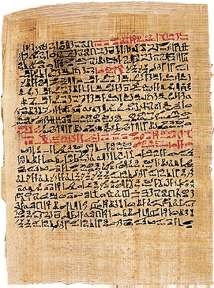
Ebers Papyrus, c1550 BCE.63 This page recounts a ‘tumour against the god Xenus’ and recommends ‘do thou nothing there against’.

Key – (1) knives; (2) drill; (3) saw; (4) forceps or pincers; (5) censer (incense or perfume burner); (6) hooks; (7)
bags tied with string; (8, 10) beaked vessel; (11) vase with burning incense; (12) Horus eyes; (13) scales; (14) pot with flowers of Upper and Lower Egypt; (15) pot on pedestal;
(16) graduated cubit or papyrus scroll without side knot (or a case holding reed scalpels); (17) shears; (18) spoons.65
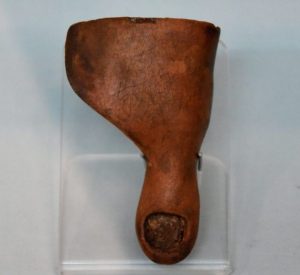
Prosthetic toe made of cartonnage (layers of of linen or
papyrus covered with plaster, rather like papier-mâché),
1070-664 BCE67
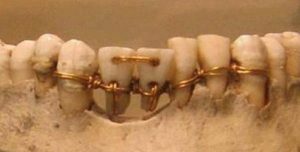
Egyptian dental bridge, c2000 BCE.68 Note the donor teeth,
mandibular osteotomy (apparently unhealed, given the lack
of remodelling), and gold wire.
Although in practice they still never wholly separated the two, Greek medical practitioners began differentiating the material from the spiritual causes of illness from 600 BCE. This entailed taking greater interest in the body itself, identifying the links between cause and effect, how symptoms related to disease, and the success or failure of various therapies.69
The most detailed Greek medical text is the Corpus Hippocraticum, which was compiled in Egypt between 323 and 31 BCE. While none are definitively ascribed to him alone, it consists of about 60 treatises attributed to Hippocrates (c460-c370 BCE).These address topics such as epidemics, joints, fractures, surgery, dreams, nutrition, dentistry, purgatives, and gynaecology. Some include case histories, while others discuss medical ethics and their relationship with non-medical subjects.70,71
The Corpus Hippocraticum indicated that patients could actually do things about their health, in particular regarding their diet and lifestyle. It also explained the importance of heat, cold and trauma in exacerbating or alleviating disease and disease symptoms, and recognised that a patient’s constitution affected their susceptibility and severity of illness.
Yet, the Greeks’ lack of distinction between philosophy and science led to the view that more could be discovered through reflection and argument than by practice and experiment. This led to a belief that disease could be caused by imbalances of the fluids or ‘humours’ – blood, yellow bile, black bile, and phlegm – within the body. As there were few clinical situations for which it could not provide a convincing (if factually wrong) explanation, the humoral theory of disease precluded any meaningful physiological research for over 2000 years.72,73,74,75 Furthermore, apart from some pioneer work by Herophilus of Chalcedon and Erasistratus of Ceos from c300 to 250 BCE, a prohibition on cadaver dissection curtailed human anatomical research until after 1300 CE.76
As previously indicated, the spiritual aspects of Greek health care were expressed via the demi-god Asclepius, son of the god Apollo and the mortal Koronis. After his mother died, Apollo gave Asclepius the gift of healing and the secrets of medicine using plants and herbs. He was also tutored by Cheiron, a wise centaur (half-man, half-horse) who also tutored other heroes such as Hercules, Achilles and Jason. In some traditions, Asclepius married the goddess of health Hygeia, and they had up to six children whose healing skills made them known as the Asclepiads. Asclepius was killed by Zeus because the gods became concerned that he could eventually raise the dead.77,78,79
The worship of Asclepius and his immediate descendants led to numerous temples (‘asclepeion’) throughout Greece and the Roman Empire, the first of which was established at Asclepius’s birthplace at Epidaurus (40km south of Corinth) after c600 BCE. Their surroundings generally reflected the beauty of nature and wonder of the gods, while their amenities included water with special healing properties for drinking and bathing, gymnasia, an abaton (dream room), exhibitions of votives and testimonials of cure, and space for rituals and festivals.80,81

Replica Greek surgical instruments, c500-400 BCE83 Note
how they are made of bronze. The bullet-shaped item
bottom centre was used for cupping.
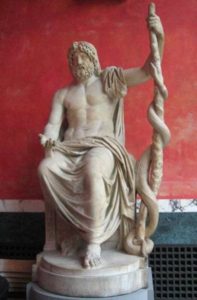
Marble statue of Asclepius, the Greek demi-god of healing84
Note the staff entwined by a single snake.
Conclusion
The period from c10,000 to c300 BCE saw the first farms, hamlets and villages become towns and cities that either had to be defended, or could be used as bases for attack. Any fighting was probably conducted by informally organised groups, who were limited in the size and scope of their operations by the supplies and social structures to sustain them, as well as the lack of reasons to fight beyond the immediate needs of their communities. Such fighting is likely to have been largely ritualistic, with few combat casualties.
However, by c4000 BCE, urban centres had developed in modern Iraq to the point where they could sustain formed armies and – for better and for worse – provide them with the means and rationales to fight. These societal developments also made it possible to integrate disparate elements such as hoplites, peltasts, archers and chariots (later cavalry), into a single combat force. Notwithstanding the technological advances in weaponry and their employment since, the need for such integration remains extant, albeit not only between combat elements but also their logistic and other enabling support services, including health.
Meanwhile, the courage of the first Egyptian seafarers should not be underestimated, not only because their ships were essentially held together with string, but also because of their reliance on memory-based inshore coastal navigation. This would have posed a major limitation for their voyages to East Africa and India (particularly if the weather deteriorated off a lee shore), where unlike the Mediterranean, the waters and coastlines would have been largely unknown to them.
Naval warfare during this period entailed cramming hundreds of men aboard ships with very lightly built hulls and limited freeboard, most of whom were there to row rather than fight unless they were ashore. These men were susceptible to penetrating injuries from spears and arrows, while an apparently under-recognised risk in the literature pertains to blunt force trauma from the rower’s own oars if they failed to unship them fast enough to prevent them being smashed. The use of ramming highlights a key concept of naval warfare throughout history: inflicting just enough damage for ‘the cruel sea’ to do the rest.
Despite such battles being fought close inshore, the more-or-less universal inability to swim meant that ending up in the water would have been fatal. Any surviving wounded were therefore limited to ships that were not sunk, or beached before sinking. The proximity to land and absence of on-board space would have led to their treatment ashore, on similar terms as if they had been fighting on land.
Although the Egyptians had developed effective surgical treatments for uncomplicated cuts, abrasions, and limb fractures by c2000 BCE, wound complications would still have had high morbidity and
mortality, while head, spinal, chest and abdominal injuries remained almost universally fatal until modern times. Furthermore, their limited ability to diagnose medical conditions, and to match diagnosis to treatment, continued to limited the latter to non-technical emotional, social and (especially) spiritual support.
By 31 BCE, the Greeks had codified their medical knowledge into the Corpus Hippocraticum, which make Hippocrates the father of Western medicine, thereby dominating medical thought for the next 1800 years. While the Greeks’ key contribution pertained to ascribing disease to material rather than supernatural causes, their lack of distinction between philosophy and science led to an aetiological theory of disease that barred meaningful physiological research, while a prohibition on cadaver dissection did likewise for anatomical studies.
The resulting stagnation in medical science had little effect on maritime operations until increasing overseas trade led to larger and more seaworthy ships, whose improved offensive and defensive capabilities in turn created further trading opportunities. Even now, this cycle remains pertinent to the economic wellbeing of many nations, including Australia.87
However, the worldwide expansion of this cycle from Europe from the end of the 15th century often led to the near or total annihilation of ship’s crews from disease and non-battle injuries. It was not until the 18th century that the role of maritime medicine as an operational enabler was recognised, which not only facilitated the European settlement of Australia, but also British maritime dominance during and after the Napoleonic Wars.88
Author
Dr Neil Westphalen graduated from Adelaide University in 1985 and joined the RAN in 1987.He is a RAN Staff Course graduate and a Fellow of the Royal Australian College of General Practitioners, the Australasian Faculty of Occupational and Environmental Medicine, and the Australasian College of Aerospace Medicine. He also holds a Diploma of Aviation Medicine and a Master of Public Health.
His seagoing service includes HMA Ships Swan, Stalwart, Success, Sydney, Perth and Choules. Deployments include DAMASK VII, RIMPAC 96, TANAGER, RELEX II, GEMSBOK, TALISMAN SABRE 07, RENDERSAFE 14, SEA RAIDER 15, KAKADU 16 and SEA HORIZON 17.His service ashore includes clinical roles at Cerberus, Penguin, Kuttabul, Albatross and Stirling, and staff positions as J07 (Director Health) at the then HQAST, Director Navy Occupational and Environmental Health, Director of Navy Health, Joint Health Command SO1 MEC Advisory and Review Services, and Fleet Medical Officer (2013-2016).
Commander Westphalen transferred to the Active Reserve in 2016.
Disclaimer
The views expressed in this article are the author’s and do not necessarily reflect those of the RAN or any other organisations mentioned.
Corresponding Author: Neil Westphalen, neil.westphalen@bigpond.com
Authors: N Westphalen 1,2
Author Affiliations:
1 Royal Australian Navy Reserve
2 Navy Health Service, C/O Director Navy Health



